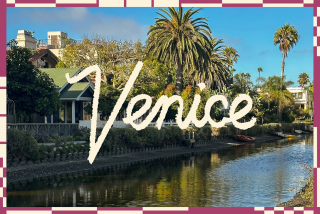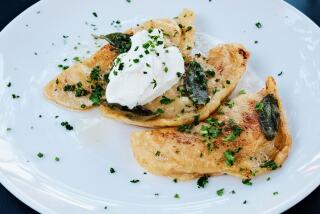The Sicilian secret known to Plato and Churchill: the food and scenery of Syracuse
Back when Plato was philosophizing about virtue and Archimedes was defining pi, the most beautiful corner of the sprawling Greek Empire was Syracuse.
That is Syracuse of Sicily, not upstate New York. How a city in a North American icebox could be named after a beautiful, sun-splashed town on the Ionian Sea would have baffled Plato himself.
He lived here. So did Archimedes. It’s nearly 2,500 years later, and Syracuse (Siracusa in Italian) remains one of the jewels of Italy.
Syracuse, Sicily’s No. 1 tourist destination, has attracted historians and beachcombers for centuries. I couldn’t think of a better place to spend a landmark birthday.
I came for four days in March with my Roman girlfriend, Marina, who said Syracuse is her favorite weekend getaway in Italy. It often is overshadowed by Taormina, 70 miles north and the place to see and be seen in Sicily.
But as Marina told me, “Taormina is no more Sicilian than Capri is Neapolitan.”
Unlike Taormina, which seems to have as many souvenir stands as it does views of Mt. Etna, Syracuse still charms with a history that overlaps half a dozen cultures, an exotic old town of narrow alleys and water-hugging piazzas and arguably the best seafood in Italy.
I thought staying healthy at 60 was difficult. Syracuse has stayed healthy at 2,750.
A maze of history
The Corinthians from the Greek island of Peloponnese settled Syracuse in 734 BC, and it became nearly as prestigious as Athens.
Then came the Carthaginians, Romans, Arabs, Normans, French and Spanish and its status changed. But remains of each culture can still be seen in Syracuse.
When we flew into Catania and drove the 30 miles south to Syracuse, I wondered what all the fuss was about. I saw a collection of dingy buildings and ugly apartment houses. I didn’t think the Greeks built Syracuse. I thought Mussolini did.
But as we walked the mile from our hotel to the old town, we could see the allure that moved Cicero to call Syracuse “the greatest Greek city and the most beautiful of them all.”
To our left we saw two long jetties. Children sat on the rocks with fishing poles in royal blue water so clear we could see the ocean bottom from the street. Fishing boats bobbed in the harbor.
Beyond the jetties stood the small island neighborhood of Ortygia, Syracuse’s old town where a multicultural people roam a maze of alleys lined with modern restaurants serving traditional Sicilian food and desserts.
I had a feeling I would have the best birthday of my life.
The best food in Italy?
We walked across a short bridge to Ortygia. Many towns in Italy have old towns, but Ortygia is really old.
With its location, hanging like a teardrop on the southeast corner of Sicily, it was the ideal R&R spot for the ancient Greek navy. Its 2,700 years of history is reflected in the uniformity of its pale yellow buildings.
We wandered the alleys under an endless line of cast-iron balconies, their green vines dangling above 18th century street lamps. Fishermen gathered on four opposite street corners to sell fresh sea urchins spread out on the sidewalk.
We passed under a small sign reading Pizzeria Caravaggio. Syracuse was where Caravaggio stopped on his run from Roman law after he murdered a man in Rome.
While in Syracuse in the early 1600s, Italy’s greatest Baroque painter did “Burial of St. Lucy,” which we saw, for free, in the nave of the Chiesa di Santa Lucia al Sepolcro.
From the church, we walked about a minute to a long ocean promenade where we took an outdoor table at Lungo la Notte Caffe. We ordered glasses d’Avola, Sicily’s popular ruby red wine.
The waiter brought us ascolani, stuffed, breaded and fried olives, and a local dish called vota vota, prosciutto-wrapped pasta.
We looked at the Ionian Sea as a lone sailboat passed languidly in front of a blazing setting sun. Marina and I agreed: The Greeks knew something about civilization.
I give Sicily my vote for Italy’s best seafood and maybe its best cuisine.
For my birthday I took Marina to Don Camillo (it’s Italian tradition that the person celebrating the birthday pays, which is why birthdays may have bigger entourages here).
The building, with stone walls and an arched, stone ceiling, dates to 1400. A window in the back wall illuminates a giant stand filled with Sicilian wines. A waiter in a sharp blue suit served me spada miele, swordfish on a pile of pickled vegetables. On the side was a spray of honey, a nod to Syracuse’s Arab conquerors who brought sweets, such as the early version of gelato.
Not far away we lunched at A Putia delle Cose Buone, featuring big flowery seat cushions that made the place look like a Sicilian grandmother’s house. I dined on spada Kalbiti: swordfish, tomatoes, capers, mint, parsley, almonds and extra virgin olive oil. I not only fell in love again with swordfish, I also learned a handy Sicilian phrase: Sapi beddu (Very good).
I never forgot that Sicily is the birthplace of the cannolo. Maybe it’s the sea or the Sicilian language that trumps Italian in the streets, but cannoli tastes better here.
They’re everywhere in Syracuse. The round, hollow shells are crisper, the ricotta cheese sweeter and the generous splashes of pistachio bits on each end make it my favorite Italian dessert.
Boat cruise encircles history
On the day of our departure, I treated myself to a boat cruise in the equivalent of a small outboard fishing boat. The hourlong trip for 20 euros, or about $22, circumnavigated Ortygia and Syracuse’s history.
I stepped on board with five Italians and set out of the quiet, calm harbor. Under a brilliant sun, we headed south and went around Ortygia’s tip, which sticks into the sea like a torpedo. How appropriate.
On that tip is Castello Maniace, a 13th century castle. Greek Gen. George Maniakes originally built it in the 11th century, Sicily Emperor Frederick II rebuilt between 1232-1240, and it was later used as a residence by Sicilian queens and as a prison.
A 2008 renovation has made the white stonework glisten in the sun.
We passed high, long cliffs of orange, gray and yellow, all colors of the beach. The boat captain, a lean man with a mop of black hair, said that when winds pick up, garbage blows in. But on this day, the turquoise sea was so crystal clear I kept looking down for scuba divers.
We motored into 20-foot high caves, carved by surf in the tufa cliffs, where the water took on an almost translucent color. We also saw the most meaningful symbol for the U.S.: a World War II memorial on the same island that the Allies liberated in 1943.
But we were all reminded about what Syracuse really represents today as we passed a lone couple on the cliff, wildly kissing in the sun.
If you go
THE BEST WAY TO CATANIA, SICILY
From LAX, Alitalia flies nonstop to Rome, and Air France, Delta, United, Lufthansa, KLM, British, Aer Lingus and Aeroflot offer connecting service (change of planes). Restricted round-trip airfares from $1,163, including taxes and fees. Alitalia, Vueling and Ryanair fly nonstop from Rome to Catania, and Swiss, Alitalia, Air Berlin, Austrian, Air Malta and Lufthansa offer connecting service. Restricted round-trip fares from $209, including taxes and fees. Buses from Catania’s airport to Syracuse take 75 minutes and cost about $7. Trains from Catania take 70 minutes and cost about $7.90.
Avoid July and August. Sicily is packed with tourists and the temperatures are warm in spring.
TELEPHONES
To call the numbers below from the U.S., dial 011 (the international dialing code), 39 (country code for Italy) and the local number.
WHERE TO STAY
Grand Hotel Villa Politi, 2 Via M. Politi , Syracuse; 0931-412121, www.villapoliti.com. Built in 1871, the Grand Hotel housed Winston Churchill during the Allied invasion in 1943. Doubles from about $130. Excellent breakfast buffet included.
Charme Hotel Henry’s House, 68 Via del Castello Maniace, Syracuse; 0931-21361, www.hotelhenryshouse.it. The 17th century palazzo was restored in 2014 and overlooks Ortygia’s waterfront. Doubles from about $205, breakfast included.
Hotel Gutkowski, 26 Lungomare di Levante Elio Vittorini, Syracuse; 0931-465861 or 0931-465830, www.guthotel,it. A seafront hotel in two buildings on the eastern end of island with two large terraces overlooking the sea. Doubles from about $90, breakfast buffet and bicycles included. Check online for specials on all hotels.
WHERE TO EAT
Don Camillo, 96 Via delle Maestranze, Syracuse; 0931-67133, www.ristorantedoncamillosiracusa.it. Romantic seafood restaurant in 600-year-old building. Entrees $18 to $34.
A Putia delle Cose Buone, 8 Via Roma, Syracuse; www.aputiadellecosebuone.it. Traditional Sicilian fare. Entrees $7-$14.
Ristorante Giove, 4 Ronco dei Cassari, Syracuse; 0931-464524 or 338-940-4775, www.ristorantegiove.com. Seafood and Sicilian dishes with outdoor seating one block off waterfront. Entrees $7-$20. Fixed-price menus $23-$28.
TO LEARN MORE
Siracusa Turismo, 31 Via Roma, Syracuse; 800-055-500, www.siracusaturismo.net, turismo@provincia.siracusa.it.
More to Read
Sign up for The Wild
We’ll help you find the best places to hike, bike and run, as well as the perfect silent spots for meditation and yoga.
You may occasionally receive promotional content from the Los Angeles Times.






